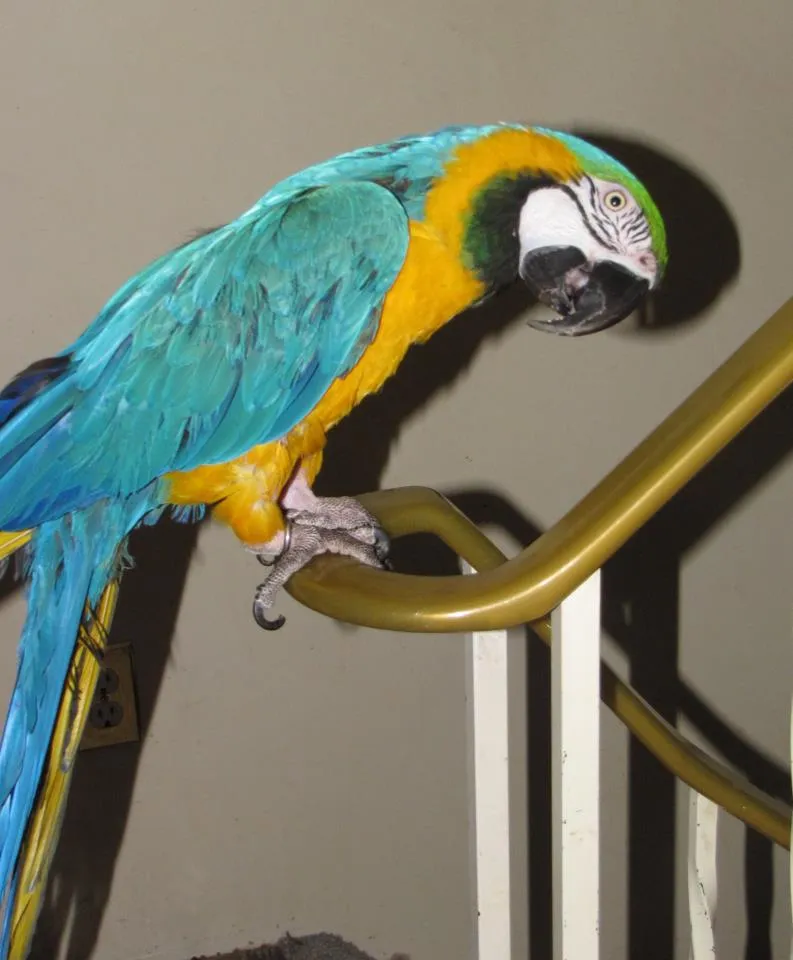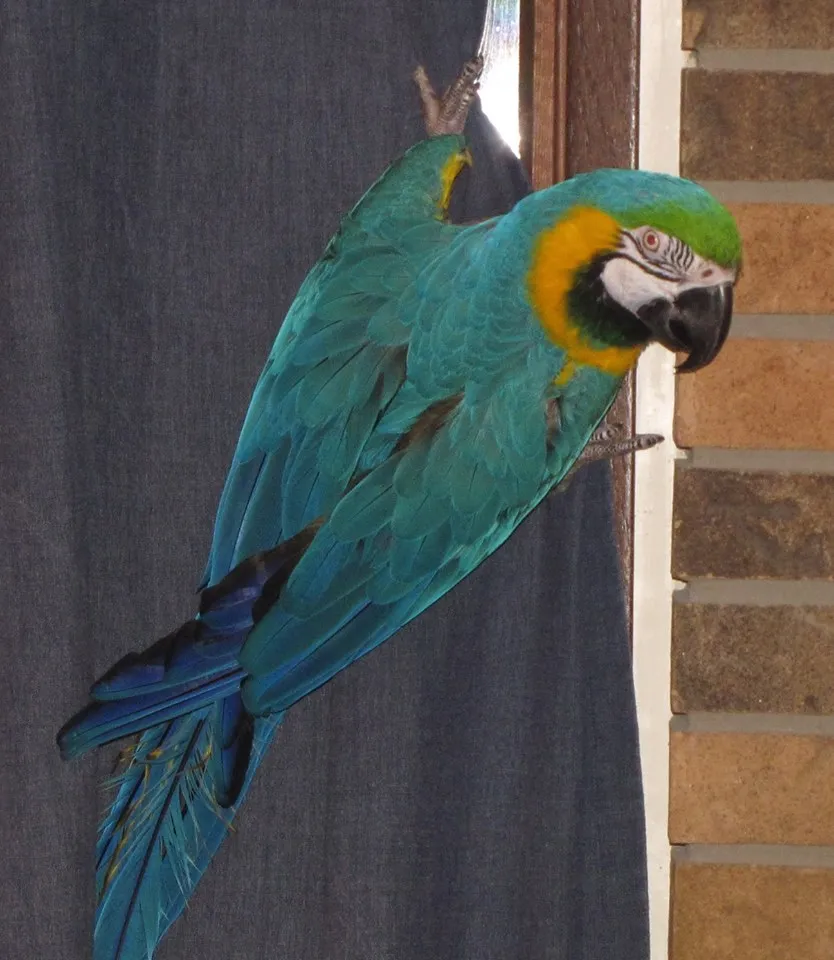Blue and Gold Macaws (Ara ararauna) are among the most captivating and popular large parrot species, renowned for their striking beauty and intelligent personalities. Their vibrant blue and golden-yellow plumage makes them instantly recognizable, but it’s their complex Blue And Gold Macaw Behavior that truly defines them, both in the wild and as companion animals. For prospective and current owners, a deep understanding of these behaviors is crucial for providing appropriate care and fostering a harmonious relationship. These magnificent birds are not just pets; they are highly social, intelligent creatures with distinct needs that require significant commitment.
The allure of a Blue and Gold Macaw is undeniable, yet their suitability as pets hinges entirely on an owner’s expectations and willingness to accommodate their natural instincts. Unlike smaller, less demanding pets, macaws are considered high-maintenance due to their considerable size, powerful beaks, and often boisterous vocalizations. Recognizing the nuances of their behavioral patterns—from their social structures in the wild to their unique expressions in a home environment—is the first step towards a successful partnership with these incredible birds. This guide delves into the various facets of blue and gold macaw behavior, offering insights to help you navigate the joys and challenges of living with one.
Blue and Gold Macaws in Their Natural Habitat
In their native environment, Blue and Gold Macaws are a quintessential sight across the northern half of South America and southern Panama. They thrive in diverse lowland habitats, even adapting to urban parks, showcasing their adaptability. These wild macaws exhibit fascinating social behaviors, often observed in small flocks that forage for fruits, nuts, and seeds. Their remarkably powerful beaks are perfectly adapted for cracking open the toughest shells, a behavior vital for their survival and nutrition.
Outside of the breeding season, these birds frequently gather in communal roosts to sleep, demonstrating a strong sense of community. However, even within these large groups, the presence of distinct breeding pairs is evident. Paired macaws typically remain close, flying and feeding together, a strong bond that persists even when not actively nesting. Observations in regions like Brazil often reveal these clear pairings within flocks, highlighting the importance of partnership and social structure in their wild blue and gold macaw behavior.
 A vibrant Blue and Gold Macaw perched on a branch, showcasing its striking blue and yellow plumage
A vibrant Blue and Gold Macaw perched on a branch, showcasing its striking blue and yellow plumage
The Complexities of Blue and Gold Macaw Behavior as Pets
Bringing a Blue and Gold Macaw into your home can either be a deeply rewarding experience or a significant challenge, largely depending on your preparedness for their intricate behavioral needs. As high-maintenance pets, their natural behaviors, which include loud vocalizations, powerful chewing, and a need for constant interaction, demand considerable time, effort, and resources from their owners. Understanding these traits is paramount to ensuring their well-being and your peace of mind.
Instinctive Chewing Habits
One of the most prominent aspects of blue and gold macaw behavior is their innate need to chew. Possessing incredibly strong beaks, these birds are naturally inclined to explore and modify their environment through chewing. This isn’t merely a destructive tendency but a vital part of their mental and physical health. Owners must provide a continuous supply of safe, appropriate chew toys made from wood, baskets, pine cones, and other parrot-safe materials. Without adequate outlets, macaws will inevitably turn their powerful beaks to furniture, walls, or other household items, driven by boredom or a lack of suitable alternatives. Regularly replenishing their toy supply, especially with natural items checked for toxicity and pesticides, is crucial for channeling this natural behavior positively.
Vocalizations and Communication
Blue and Gold Macaws are renowned for their talking abilities, often learning a wide range of words and phrases. Their capacity for mimicry can be impressive, allowing them to greet visitors with an enthusiastic “Hi!” or mimic other household sounds like a dog’s bark or human laughter. However, relying solely on a macaw’s talking ability as a reason for ownership can lead to disappointment. Not all macaws become proficient talkers, and even those that do will also engage in a significant amount of natural macaw vocalization.
Their natural repertoire includes a variety of loud screeches and squawks, which, while natural, can be extremely high-pitched and unsettling in a home environment. While behavioral modification techniques can help minimize excessive noise, it’s unreasonable to expect a macaw to be a quiet pet. These vocalizations are a core part of blue and gold macaw behavior, used for communication, alarm, and expressing various emotional states. Owners must be prepared for the noise and understand that it is a normal, albeit sometimes challenging, aspect of owning these birds.
 Pteri, a Blue and Gold Macaw, playfully climbing on house curtains, demonstrating curious exploratory behavior
Pteri, a Blue and Gold Macaw, playfully climbing on house curtains, demonstrating curious exploratory behavior
The “Mess Factor” – Natural Habits Impacting Environment
Macaws are known for being among the messiest companion birds, a direct consequence of their natural feeding and play behaviors. Their diet, often including nuts in the shell, results in discarded shells scattered outside their cage. Similarly, the woody debris from their beloved chew toys will inevitably find its way beyond the cage bars. This “mess factor” is simply an extension of their natural exploratory and foraging habits. They are not intentionally messy but rather follow their instincts to break apart food and toys, creating a spread of particles in their immediate surroundings. Owners should anticipate regular clean-up and consider cage designs or protective floor coverings to manage this inherent aspect of blue and gold macaw behavior.
Understanding Their Powerful Beaks and Bite Prevention
The sheer size and strength of a macaw’s beak can be intimidating, and rightly so, as a bite can be very painful. Blue and Gold Macaws can effortlessly crack open hard nuts, demonstrating the force they can exert. However, it’s important to understand that biting is often a last resort and a form of communication within blue and gold macaw behavior. Macaws are not subtle in their body language and will typically provide clear warnings before they bite. Signs of agitation include a lowered head, pinned pupils, and erect head feathers. Lunging and shrieking are also common pre-bite signals.
Respecting these warnings and not attempting to handle an agitated bird is crucial for preventing bites. Early training with positive reinforcement, teaching a macaw to step up onto an arm or perch, can significantly improve handleability. Birds trained with force are more likely to become biters, while those handled by multiple people from a young age are less likely to become “one-person birds.” Critically, potential owners must not be intimidated by the bird. Fear can lead to less handling, which in turn can make the macaw more unsure, nippy, and difficult, creating a negative cycle. Confidence and consistent, positive interaction are key to managing this aspect of their behavior.
Social Needs and Interactive Behavior
Blue and Gold Macaws are incredibly social creatures, and their demanding need for attention is a central component of their behavior. These are not birds that can be left in a cage all day; they thrive on interaction and being part of their human flock. They often seek proximity to their owners, wanting to perch nearby, engage in vocal exchanges (even if the responses are nonsensical), and will often loudly demand to be let out of their cage if they feel neglected.
This high social drive also translates into their impressive capacity for learning tricks and engaging in interactive play. Their intelligence and energetic nature make them highly responsive pets for owners willing to invest the time in training and bonding. Ignoring their social needs can lead to frustration, destructive behaviors, and excessive noisiness. Providing ample opportunities for interaction, enrichment, and mental stimulation is vital for a well-adjusted and happy Blue and Gold Macaw.
 A Blue and Gold Macaw looking attentively, highlighting its intelligent and social demeanor
A Blue and Gold Macaw looking attentively, highlighting its intelligent and social demeanor
Dietary Behavior and Nutritional Needs
A well-balanced diet is fundamental to the health and behavior of Blue and Gold Macaws. Most macaws thrive on a high-quality pelleted diet, which should form the cornerstone of their nutrition. This pelleted base should be supplemented with a variety of nuts (such as walnuts, pecans, hazelnuts, and almonds), seeds, fresh fruits, and vegetables. Additionally, they can enjoy other healthful “people” foods in moderation. Providing a diverse diet not only ensures they receive all necessary nutrients but also offers mental stimulation through varied textures and tastes, encouraging natural foraging behaviors. It’s important to research safe foods and avoid anything toxic to parrots.
Further Resources for Macaw Behavior and Care
For those seeking to deepen their understanding of blue and gold macaw behavior and care, several valuable resources are available. Positive reinforcement training methods are highly effective with macaws, and books such as The Parrot Problem Solver by Barbara Heidenreich and Clicker Training for Birds by Melinda Johnson offer excellent guidance.
While some comprehensive works like The Large Macaws: Their Care, Breeding, and Conservation by Joanne Abramson et al. may be out of print and hard to find, checking libraries for inter-library loan options can be fruitful. Additionally, Avian Publications often provides basic macaw care guides that can be very helpful for new owners. Consulting with an avian veterinarian or experienced macaw owner can also provide invaluable practical advice tailored to your specific bird.
Conclusion
Understanding blue and gold macaw behavior is not just about appreciating their beauty; it’s about acknowledging the complex, intelligent, and demanding nature of these magnificent birds. From their social structures in the wild to their instinctive chewing, vocalizations, and intense need for social interaction in a domestic setting, every aspect of their behavior requires dedication, patience, and a well-informed approach from their owners. While they present unique challenges, the bond formed with a well-cared-for Blue and Gold Macaw can be incredibly rewarding. By respecting their natural instincts and providing an enriching environment, you can foster a relationship built on trust and mutual understanding. Dive deeper into the world of macaw care and discover the profound joy of these extraordinary companions!
